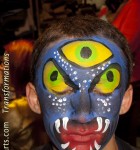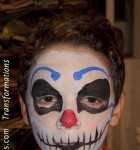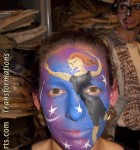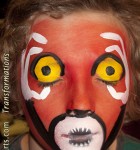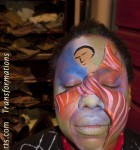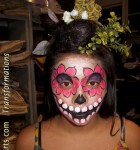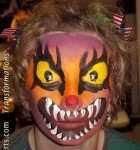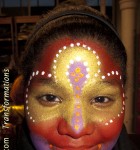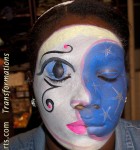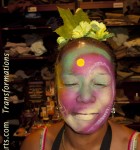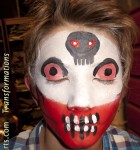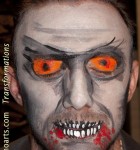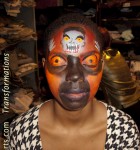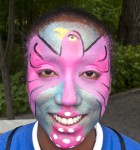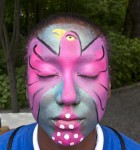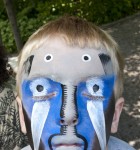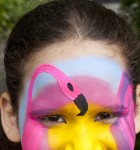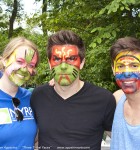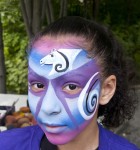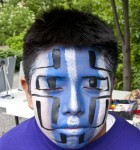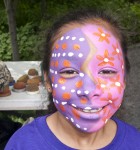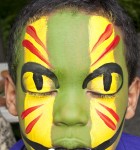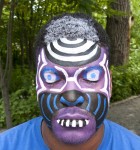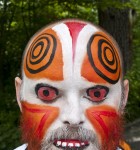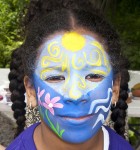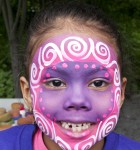 by Christopher Agostino
by Christopher Agostino
For all of my artistic life I have depended on the willing participation of another person. Even the simple act of painting a face requires the acquiesce of the person with the face to be painted. So much more so the body model. I think about this relationship between bodypainter and model a lot, and it is at the essence of the question “why body painting?”
I can’t take a canvas off a shelf and just start bodypainting, and I can’t buy a model at Michael’s. A body model is not an object, not a commodity. They talk, move, think and feel while you are painting them. What would it be like painting a canvas that talked to you? Or that had an opinion of the painting as you were doing it?
We entrust our art to the model, as they trust us when they let us paint them. There is an exchange of intimacy in the collaboration between artist and model: the obvious physical intimacy of the model letting an artist paint their body in exchange for the artist giving them entrance into his vision and the act of creation.
In describing my experience collaborating with models, I can’t speak for all bodypainters, and probably not for most professional bodypainters. I don’t paint in competitions, and don’t take a lot of commercial work. If the painting is for a performance or someone else’s project the process is specific and my role is to support the vision of the director and function like a makeup artist or costumer to make the performer feel confident and look good. Sometimes in teaching settings or painting at the Kryolan booth at a convention the goal is specific and limited, and I may approach that body painting as a sketch or exploration, or repeat something I’d done before because I know it works. In those cases I’m hoping for a model that is professional, comfortable being painted and pleasant to talk to and spend some time with as we work.
It is when I have a strong vision for a realized fine art design I am trying to achieve—whether painting in studio with the goal of generating that one key photograph or painting in public as performance art—that I have come to understand how deep my collaboration with the model is, that I am as dependent on the model as they are on me for success. I need more than the acquiescence of the model, I need their support, their encouragement, to allow me to take chances. I especially need them to let me be vulnerable and to risk failure. It’s not something you have to ask of a canvas off the shelf, and it’s an understanding I’ve only come to learn about my process through the years, and through the failures, as I have tried to find my way forward in this art.
I don’t think this is true of more experienced, professional bodypainters, but I’m not sure.
Behind the question I’ve been addressing in this series of posts, “why body painting?”, is the larger question, “why art?”, and the specific question of why did I choose to be an artist? As a generalization, I think artists are compelled to create art—I couldn’t say why or how, maybe in response to having an awareness of life that seems to them different than the norm, and so the desire to change the norm or at least express their difference. Beyond that original impetus, I can say for myself that a large part of what keeps me creating art is the excitement of the fight, the struggle to succeed, to “win”. In much the same way I imagine an athlete must feel, setting out to create a painting feels to me like a competition, albeit an internal one between me and the limitations of my abilities to bring that idiosyncratic vision I identify as myself into the world as a physical, undeniable reality, an “object of art”.
Artists strive for the edge, both in the sense of a place they’ve never been and in the sense of a place they are unsure of, walking the razor’s edge, unsure of their footing. I’ve felt that edge most keenly in performance before an audience, especially on stage alone trying new material, unsure of how to perform it and knowing that success or failure is in my hands—and audiences let you know if you fail. I’ve also felt it late at night all alone in my workshop making a sculpture out of a piece of clay, or painting a canvas—though it’s so much harder to assess success or failure in that setting and I’m sure I’m not the only visual artist who sees the things they’ve created over the years and remains uncertain of which category they fall into.
But, speaking strictly from my own experience, there is something about body painting that feels different. Added to the usual angst of creating art is the awareness of its immediacy and ephemeral nature—you get it right or you don’t, like a performance—but it’s also there before you as a physical object. That “object” is a person, a person whose participation I appreciate and whose feelings I care about, and I want to succeed for them as well as for me. They are becoming the art I am making and I feel responsible for that in a way I’d never feel for a lump of clay, and maybe that connection to the human I am working with helps me reach deeper. The model is also invested, showing me confidence by giving me permission to paint them, plus the time and physical sacrifice involved (unless you have been bodypainted or done a bunch of bodypainting I don’t think you can understand quite what a body model is agreeing to when they let you paint them—we artists ask a lot, they work hard). Often the models I paint also help with the design and the process, making suggestions, showing me movement ideas, helping with decisions, in addition to the beauty of who they are that they bring to the painting in a way beyond any other canvas can. When it’s really working, the model is right there at the edge with me. In a stage performance, you work to energize and engage the audience so that you can soar on their wings to new heights. When bodypainting, it is more of a direct collaboration, if we are to fly we fly together.
And then, there is that magic thing that happens when I finish the painting and now the model takes it, owns it, brings it to life—takes it away from me and makes it more than I had conceived of. This is the pivotal difference between painting a person and painting a canvas. Not only does the art come to life, but as soon as I am done it is no longer mine, it has a life of its own now—how different that feels than seeing a canvas I’ve painted hanging on a wall.
The ultimate lesson I have learned from models is about my own limitations. I don’t believe I can transcend a model’s limitations, whereas I know they can transcend mine. I’ve seen it happen, I’ve seen a model take the limited work of my art and make it into something more. That alone would be answer enough to “why body painting?”
—————————————

Painting Becca at FABAIC 2007
I’ve had quite a number of very positive collaborations with models, here are just a few practical examples of how models have helped me, helped my art.
The first time I painted someone as a recognizable, famous painting, the Picasso “Seated Woman, 1937” image in the previous post, it was because Becca told me to paint something on her I’d always wanted to try but never had the chance, and that I could take as long as needed to work it out as we went. I had a few months earlier painted some kids with Picasso faces, for a museum exhibit of his work, and with her encouragement tried it as a bodypainting. (Recently she flew to New York to let me paint her for a project with no pay, and made me feel like I was doing her the favor.)
Just as I was starting to experiment with modern art imagery, I did several paintings with Emma, who is an art historian as well as a dancer, and it was an education for me as we talked about the concepts behind the imagery. I appreciated how, given her background, she saw that what I was working to achieve was valid as fine art.
You can’t be a bodypainter without a body model. And yet, it feels like we aren’t that kind to them, asking them to stand there, forever, not moving, without any clothes on, and after all that, that’s when we want them to work even harder, bringing the art we just painted to life. I’d spent hours painting Christina at the Kryolan booth at FABAIC 2009. When we were done, it was late. Still, she went on to pose for hours. First for spectators, than for one photographer, and finally for the convention photographer, Lisa Konz. By that point it was maybe 2:00 am and Christina wouldn’t quit until she got the photo right, the photo at the top of the post of her leaping that became my Painted Bodies Living Art logo. Once the body is painted, we depend upon the model to present it at its best, even better than we conceived of it—and also on the photographer to capture it and preserve it. The result is a collective, collaborative art work.
Thank you to all of the models who have joined me in this adventure over the years.

Emma, as Cubist Tiger Pop

Christina also worked hard to get this wonderful action shot, photographed by Lisa Konz
Learn more at my Body Painting Page https://thestorybehindthefaces.com/body-painting/

 At our annual New York events like this one, folks are familiar with the freedom and creativity we bring to each face and that encourages us to try new ideas, like this combination of a Monet color background with a dancing figure from an Andre Derain painting, as I continue to explore putting dancing figures on people’s faces. And I took the opportunity to do some “sketches” for faces I’ll be painting for a Dia De Los Muertos performance by Calpulli Mexican Dance Company on Nov 3 and 4 at Pace University’s Schimmel Center.
At our annual New York events like this one, folks are familiar with the freedom and creativity we bring to each face and that encourages us to try new ideas, like this combination of a Monet color background with a dancing figure from an Andre Derain painting, as I continue to explore putting dancing figures on people’s faces. And I took the opportunity to do some “sketches” for faces I’ll be painting for a Dia De Los Muertos performance by Calpulli Mexican Dance Company on Nov 3 and 4 at Pace University’s Schimmel Center. Continue reading
Continue reading
